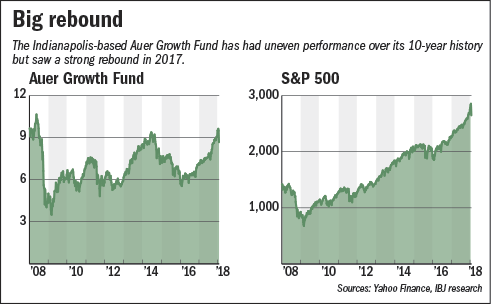Subscriber Benefit
As a subscriber you can listen to articles at work, in the car, or while you work out. Subscribe NowThe stock market has taken the Auer Growth Fund and its investors on a heck of a ride over the past decade.
The fund’s returns have careened from some of the worst among similar funds just a few years ago to some of the best last year. But its managers have never swayed from their high-growth vision.
The Indianapolis-based mutual fund has posted cumulative returns of negative 0.43 percent since 2008. That places it among the worst performers within the “small blend” category, which includes funds that invest in both growth and value stocks from smaller companies.
The category delivered 8.89 percent growth during that period. In comparison, the S&P 500 delivered 10-year returns of 9.69 percent.
But things turned around for the Auer Fund in a big way last year, with 2017 returns of 28.75 percent. That outperformed the S&P 500’s 21.83 percent.
It was also good enough to place Auer among the top 1 percent of small-blend performers, according to mutual-fund tracker Morningstar. The category’s one-year returns were 12.28 percent.
 Auer
Auer“There’s probably not another fund in the country that has that,” Senior Portfolio Manager Bob Auer said of the Auer Fund’s huge performance swing.
Auer is also the founder of investment firm SBAuer Funds LLC, whose office is in the Keystone at the Crossing area on the northeast side.
What hasn’t changed along the way is the fund’s investment strategy, which has remained the same since inception. In a nutshell, the fund buys stock in companies that have at least 25 percent growth in quarterly earnings and at least 20 percent growth in quarterly revenue, with a price-to-earnings ratio below 12. The fund doesn’t buy stocks that don’t fit that profile, and if a stock falls outside the parameters, it’s out of the fund.
“We literally look at every stock every quarter,” Auer said. “We’re trying to catch the stock in the first good quarter they’re having.”
That means the mix of stocks is constantly changing. The fund currently owns stock in 91 companies representing a variety of industries, including energy, basic materials (coal, aluminum, steel and the like), technology and others. No single stock represents more than 5 percent of the total fund.
The precursor to the public Auer Fund launched in 1987, when Auer was a stockbroker at the company now known as Morgan Stanley and his parents opened a $100,000 retirement account with him. Auer’s father, Bryan Auer, had tinkered with various investment strategies before coming up with the “25/20/12” formula the fund still uses today.
“We’ve basically operated it the same since the day we started,” Bob Auer said.
By 2007, with minimal additional contributions by his parents, Auer said, that $100,000 had grown to $32 million. At that point, Auer decided to open the fund to outside investors.
“It’s a very simple formula that over the years has worked very well,” said Dave Gilreath, managing director and chief investment officer at Indianapolis-based Sheaff Brock Investment Advisors LLC. Sheaff Brock’s parent company, Sheaff Brock Capital Management LLC, is both a part owner of SBAuer Funds LLC and serves as the Auer Fund’s chief compliance officer.
However, Gilreath said, the fund’s strict investment strategy also leaves it open to wild performance swings.
“It’s kind of a boom or bust,” he said. “When you’re surfing out in the ocean and you catch the right wave, it can be fantastic. But otherwise, you’re sitting out with the sharks circling around you.”
Because it invests only in companies that have both high growth and a low price-to-earnings ratio, most of the Auer Fund’s holdings are in very small companies, Gilreath said. Large companies rarely enjoy the type of growth the fund seeks, and those that do probably have a price-to-earnings ratio too high to meet its criteria.
The small- and micro-cap stocks Auer owns “are just inherently more volatile” than those of larger companies, he said. These stocks are also not widely purchased by other funds.
This means the Auer Fund’s holdings don’t look like those of other funds and, as a result, the fund’s performance can differ widely from both other mutual funds and from the stock market overall.
“They truly don’t care at all what the market’s doing because all they care about is the companies that they own,” Gilreath said.
The fund launched publicly Jan. 1, 2008, offering 3.2 million shares priced at $10 each. Then the Great Recession hit, and by that November, shares dropped as low as $3.50.
 “We’ve been digging out of that hole ever since,” Auer said.
“We’ve been digging out of that hole ever since,” Auer said.
There were good years, including a 44 percent return in 2013. But then the prices of many of its holdings sunk after oil prices and commodities declined.
Lately, the fund has been on the upswing.
In 2017, it was invested in a number of home-building companies, Auer said. Those companies had a good year after a long stretch of poor performance, which helped boost returns. The fund also added holdings in energy and technology companies, which Auer said also helped.
Even with its winning 2017 performance, the Auer Fund faces challenges.
As of Nov. 30, which marked the end of the fund’s 2017 fiscal year, it had $31 million in assets under management. That includes the investment of Auer’s parents, both 82.
The fund’s size has shrunk in recent years, in large part because investors have taken their money elsewhere.
In 2013, the fund had $77 million in assets under management. That dropped to $66 million in 2014, $35 million in 2015, and $25 million in 2016.
In 2017, Auer said, the size of the fund shrank $1.6 million more. That includes $2 million that existing shareholders cashed out, along with $400,000 in new investments.
“That $400,000 was the most we’ve had in five years,” Auer said. In comparison, he said, investors withdrew $12 million in 2016 and $40 million in 2015, with new investments of $100,000 or less each of these years.
Auer said he remains committed to the fund’s investment strategy, and he pointed to last year’s returns as proof that it works.
At the same time, he conceded that attracting new investors will not be easy.
Morningstar rates funds on a scale of one to five stars, and the Auer Fund carries a one-star rating. Morningstar assigns ratings using a bell-curve distribution—the 10 percent of lowest-performing funds earn only one star.
Marketing the fund is “a huge challenge because the star ranking carries so much weight,” Auer said.
Morningstar’s ratings are based on a fund’s three-, five- and 10-year performance. If the Auer Fund has another strong year in 2018, Auer said, that should boost its Morningstar metrics. At that point, the fund will reach out to financial advisers who might be interested in recommending it to their clients.
 Evans
EvansMorningstar is “one of the most respected mutual fund databases out there,” said Rick Evans, a certified financial planner with Indianapolis-based Valeo Financial Advisors LLC.
Evans said he is not familiar with the Auer Fund, but that, in general, a one-star rating might turn off potential investors. So might the fund’s expense ratio of 2.5 percent, which Evans described as “fairly high, relatively speaking.”
For its part, the Auer Fund says its fees are warranted because of the work involved in evaluating earnings reports in search of investment opportunities.
The fund’s aggressive investing style also carries a degree of risk that not all investors will be comfortable assuming, Evans said.
“You would have to be a pretty patient investor to ride the type of roller-coaster ride that this one’s going to take you on,” he said.
Auer said he’s optimistic that tax reform will keep the economy humming and that the stock market will remain strong, despite sell-offs of recent days.
“It makes sense that the market pulls back 5 percent, maybe even 10 percent,” Auer said on Feb. 2. “But I don’t think the bull market is over.”•
Please enable JavaScript to view this content.
